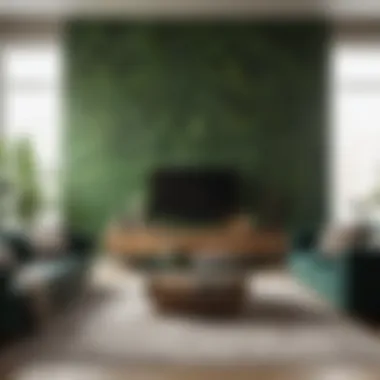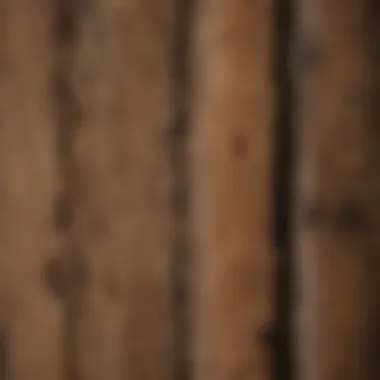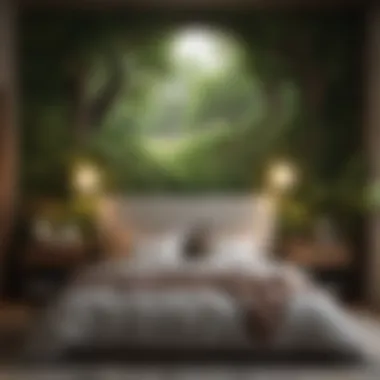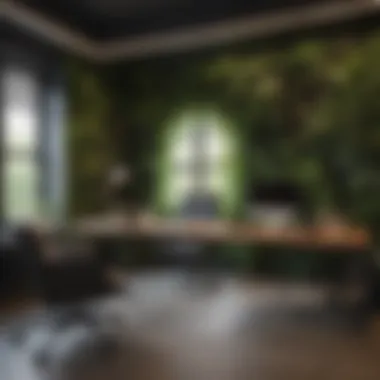The Rise of Natural Look Wallpaper: A Guide to Stylish Interiors


Intro
Natural look wallpaper has emerged as a noteworthy trend, capturing the interest of homeowners and interior design enthusiasts alike. This style offers a unique charm that resonates with those who appreciate organic aesthetics within their interiors. Instead of merely providing a surface covering, these wallpapers create an immersive environment, mimicking elements found in nature. The rise of this design trend reflects a growing desire to bring the tranquility of the outdoors into the living spaces.
The materials used in natural look wallpaper vary widely, from sustainable paper to vinyl that imitates natural textures. Additionally, this type of wallpaper serves various applications, from feature walls to entire rooms. Its versatility makes it suitable for both modern and traditional settings. The articles aims to discuss not only the aesthetic appeal and practical aspects of natural look wallpaper but also the upcoming trends in this domain.
As we delve into the various sections of this guide, homeowners and design enthusiasts will gain insights into trending styles, color palettes, maintenance, and installation techniques. By understanding these elements, individuals can make informed decisions that ultimately enhance their living environments.
Prologue to Natural Look Wallpaper
The significance of natural look wallpaper has grown tremendously in recent years. This trend aligns with a broader movement towards wellness, comfort, and sustainability in home and commercial design. Many people seek out ways to bring elements of the outdoors inside. Natural look wallpaper serves as an effective solution. It offers a connection to nature, enhances the aesthetic, and often creates a calming atmosphere.
Definition and Characteristics
Natural look wallpaper refers to wallpapers designed to mimic organic materials found in nature. This includes textures and patterns resembling wood grain, stone surfaces, and plant life. The key characteristics of this wallpaper type include:
- Realistic Patterns: High-quality printing technology allows for exceptionally realistic designs that can confuse the eye.
- Varied Textures: Some wallpapers add tactile elements. Wallpaper can include textures that replicate natural surfaces.
- Diverse Materials: Natural look wallpaper comes in papers, vinyl, and textiles. Each material has its own qualities, suitability, and maintenance needs.
Natural look wallpaper helps create an inviting and organic feel in any space. This approach often encourages a sense of grounding and tranquility.
Importance in Interior Design
Incorporating natural look wallpaper into interior design is more than just a visual choice. It reflects a shift towards biophilic design, which emphasizes connecting indoor spaces with the natural environment. This type of wallpaper:
- Enhances visual appeal without overwhelming the senses.
- Supports mood recovery and mental well-being by bringing elements of nature indoors. Studies show that people often feel calmer and more centered in naturally designed spaces.
- Offers sustainability, especially if sourced from environmentally friendly materials. Designers and homeowners alike appreciate products that minimize environmental impact.
In summary, natural look wallpaper is an essential facet of modern interior design. It provides a seamless blend of aesthetic enhancement and emotional well-being, creating spaces that are visually stunning and psychologically comforting.
The Appeal of Natural Aesthetics
Natural look wallpaper has gained prominence for its ability to enhance interiors through organic elements. This trend reflects a broader aesthetic shift in interior design that seeks to create harmonious spaces. The appeal lies in its versatility, allowing homeowners to incorporate natural beauty without the high maintenance associated with real materials.
Creating an Organic Environment
One primary motivation behind the appeal of natural look wallpaper is its capacity to foster an organic environment. Such spaces often evoke feelings of tranquility and comfort. Whether it mimics the rustic charm of wood or portrays the subtle patterns found in stone, these wallpapers can seamlessly blend with other design elements. They promote a sense of connection to nature, allowing individuals to feel more grounded.
- Incorporating natural patterns can soften sharp edges typical of modern architecture.
- Textures can add depth to a room, making it feel more inviting.
- Color palettes often feature earth tones, which are generally calming and pleasant.
In practical terms, a room adorned with natural look wallpaper can become a serene retreat from the fast-paced and synthetic environments outside. It encourages relaxation and sparks creativity, making it ideal for various settings, such as living rooms and bedrooms.
The Biophilic Design Movement
Another significant aspect of the appeal of natural aesthetics is its alignment with the biophilic design movement. Biophilia focuses on the human-nature connection, emphasizing that integrating natural elements into our living spaces can enhance well-being.
Natural look wallpaper plays a crucial role in this design philosophy by:
- Providing visual references to nature, which can elevate mood and reduce stress.
- Encouraging positive physiological responses by bringing the outdoors in through visuals.
- Creating a more appealing and functional environment that aligns with wellness principles.
"Biophilic design is about creating environments that connect people with nature for improved well-being and performance."
This movement drives the choice of wallpaper towards those that reflect natural landscapes or habitats, reinforcing our intrinsic connection to the environment. In today's interiors, choosing natural look wallpaper is more than an aesthetic choice; it is a reflection of values advocating sustainability and well-being.
Varieties of Natural Look Wallpaper
Natural look wallpaper plays a vital role in interior design by offering a wide range of materials and designs that can transform any space. The exploration of varieties helps homeowners and enthusiasts understand their options and make informed decisions. Different materials exhibit unique qualities, allowing for specific preferences to align with the desired aesthetics and functionality. Furthermore, popular patterns offer insights into current trends, ensuring that selected wallpapers not only enhance a room's decor but also reflect personal taste and contemporary styles.
Materials Used
Paper


Paper wallpaper has a classic appeal stemming from its versatility and ease of application. Often made from sustainable sources, this type is a top choice for those who value eco-friendliness. One key characteristic is that paper wallpapers come in a variety of textures and finishes, making them suitable for a range of design styles. Their lightweight nature allows for straightforward installation, which can be a significant advantage when you want to refresh a room. However, paper is less resistant to moisture, which can be a disadvantage in areas like kitchens and bathrooms.
Vinyl
Vinyl wallpaper stands out due to its durability and ease of maintenance. It tends to be water-resistant, making it a smart choice for high-traffic areas or spaces prone to humidity. A significant characteristic of vinyl is its ability to mimic various textures and materials, providing homeowners access to realistic finishes like wood or stone. The unique feature of vinyl wallpaper is its wipeable surface, allowing for easy cleaning without damaging the design. On the downside, vinyl may not always be environmentally friendly, depending on the manufacturing process.
Textile
Textile wallpaper offers a luxurious touch that appeals to many interior designers. This type of wallpaper provides depth and richness, with its fabric-like appearance being a signature trait. Many textile wallpapers are made from natural fibers, which can enhance indoor air quality and contribute to a more organic feel. A notable advantage of textile wallpaper is the warmth it provides to a room. However, its texture can make cleaning more difficult, as stains might be harder to remove compared to other materials.
Popular Patterns and Designs
Wood Textures
Wood textures in wallpaper provide an earthy ambiance that many find appealing. The ability to replicate the natural look of wood grain lets homeowners introduce warmth and sophistication into their spaces without the expense of real wood. A key characteristic of wood texture wallpaper is the range of finishes available, from rustic to polished looks. This versatility makes it suitable for various design preferences. The downside is that some may consider it less authentic compared to actual wood products.
Stone Effects
Stone effects in wallpaper serve a functional aesthetic, imitating the rugged charm of natural stone. They can introduce a sense of stability and strength to a room's design. The unique feature here lies in how these wallpapers can create depth through realistic textures. While effective, stone effect wallpapers may require a careful selection of colors to ensure a cohesive look. Remember that the heavier appearance can deter some from using it in lighter, airier spaces.
Floral Motifs
Floral motifs continue to be popular due to their ability to bring life into interiors. These designs can convey freshness and tranquility while being suitable for both modern and traditional rooms. One crucial aspect of floral designs is their ability to brighten up a room, offering an uplifting ambiance. The unique feature is the variety of styles available, from bold, contemporary prints to delicate, vintage designs. However, excessive floral patterns can sometimes overpower smaller spaces, so careful consideration is needed when choosing them.
Applications in Various Spaces
The utilization of natural look wallpaper transcends basic decoration; it plays a significant role in enhancing the aesthetic and functionality of diverse environments. This section navigates the specific applications of this wallpaper type in living rooms, bedrooms, kitchens, dining areas, and commercial spaces. Each application illustrates how the right wallpaper can create a specific mood, blend seamlessly with existing decor, and provide a sense of warmth and comfort.
Living Rooms
In the living room, natural look wallpaper serves as a focal point that can unify disparate design elements. Many homeowners seek to create a relaxing atmosphere here, making it the ideal space for organic patterns such as wood textures or leafy motifs. These designs can evoke feelings of being outdoors, enhancing the overall ambiance.
A calm and inviting environment can encourage social interactions among family and guests. Additionally, patterns such as warm bamboo or solid slate can complement furniture choices, making a space feel curated yet cozy.
- Key benefits:
- Enhances visual interest without overwhelming the senses.
- Provides a backdrop for creativity and personal expression.
- Encourages relaxation through nature-inspired elements.
Bedrooms
The bedroom is often considered a sanctuary, a space for rest and rejuvenation. Implementing natural look wallpaper can significantly enhance this tranquility. Soft, natural patterns like serene floral designs or textured stone can add an element of naturalness, promoting a peaceful state of mind.
When selecting wallpaper for a bedroom, consider:
- Colors: Soft and muted tones that reflect a calming vibe
- Patterns: Subtle designs that do not dominate the space
- Material: Consider textile options for added warmth and intimacy
Such choices not only align with the function of the bedroom but also improve overall sleep quality and comfort.
Kitchens and Dining Areas
The kitchen and dining areas are the heart of a home. They often serve both functional and social purposes. Natural look wallpaper can enhance these spaces by bringing in earth tones and textures that enhance warmth and hospitality.
In kitchens, wallpapers can be used to complement cabinetry and countertops. For example, a wood grain design can harmoniously blend with maple or oak surfaces, creating a cohesive visual experience.
For dining areas, floral or herbaceous designs can instill a rustic charm, making meals feel more inviting.
- Considerations include:
- Durability: Select wallpapers that are easy to clean and moisture-resistant.
- Matching Elements: Consider decor, table settings, and accessories for a cohesive look.


Commercial Spaces
In commercial settings, the use of natural look wallpaper can convey a strong brand identity while also providing comfort to clients and employees. Businesses such as cafes, boutiques, and offices benefit from creating an inviting environment that enhances customer experience.
For instance, a cafe using natural textures like brick or stone can create an earthy vibe that appeals to patrons seeking comfort. In offices, selecting calming patterns can foster productivity and reduce stress levels among employees.
- Advantages for commercial spaces:
- Boosts brand perception by aligning aesthetic with values.
- Creates an environment that promotes interaction and satisfaction.
- Provides an opportunity for differentiation from competitors.
Benefits of Natural Look Wallpaper
Natural look wallpaper offers more than just an appealing visual style. Its importance in interior design stems from various factors, including aesthetic enhancement, mood improvement, and environmental consciousness. This section will explore these benefits in detail, demonstrating how such wallpaper can transform a space into an inviting and stylish area.
Aesthetic Enhancement
The primary benefit of natural look wallpaper is its ability to enhance the aesthetics of a room. With its realistic textures and patterns, this type of wallpaper imitates materials found in nature, such as wood, stone, or leafy motifs. These designs can create a more cohesive environment that connects indoor spaces with the outdoors.
When interior designers select wallpaper, consideration often focuses on how it complements existing furnishings. Natural look wallpaper can serve as a stunning backdrop or a focal point, depending on the design. Homeowners can choose from various colors and patterns that reflect their personal style while promoting a sense of harmony within the space.
For instance, wood grain wallpapers can give a warm feel to a living room, while floral designs may bring freshness to a bedroom. This versatility makes natural look wallpaper a favored choice for many.
Mood and Ambiance Improvement
Another significant advantage is mood enhancement. Natural aesthetics are known to evoke feelings of calmness and relaxation. By incorporating natural look wallpaper, spaces can radiate warmth and comfort.
Research shows that natural elements in design can have a positive effect on mental health. Biophilic principles emphasize the importance of nature in architectural design. Natural look wallpaper embodies this principle by simulating a natural environment indoors, thereby contributing to better mood and focus.
Furthermore, the right pattern can also influence the ambiance of a space. Soft, flowing lines can promote tranquility, while bolder patterns can energize a room. Homeowners should consider the intended use of each space when choosing wallpaper to best suit the desired mood.
Environmental Considerations
Sustainability in home design is increasingly critical. Many natural look wallpapers are made from eco-friendly materials, reducing the environmental footprint. For example, wallpapers made from recyclable papers or water-based inks fulfill eco-conscious design needs. Homeowners can make a thoughtful choice that reflects their values by selecting such options.
Moreover, natural look wallpaper often requires less maintenance compared to traditional wall treatments. This lower upkeep allows homeowners to reduce their overall resource consumption while maintaining the aesthetic quality of their interiors.
"Incorporating natural elements in design can lead to improved mental well-being and serenity."
Consider the versatile use of natural look wallpaper to create a personalized and environmentally conscious home.
Installation of Natural Look Wallpaper
The installation of natural look wallpaper is a significant part of achieving the desired aesthetic in any space. It provides an opportunity to create visually appealing and cohesive interiors. Proper installation not only ensures that the wallpaper looks its best but also increases its durability. Missteps during installation can lead to problems such as peeling or bubbling, which detracts from the look and can necessitate costly repairs. Understanding the installation process is essential for homeowners and interior enthusiasts alike, as it enables them to appreciate the beauty and practicality of natural look wallpaper.
Preparation of Walls
Before wallpaper installation, the preparation of the walls is crucial. A clean, smooth surface is essential for good adhesion. Here are steps to prepare the walls:
- Clean the Surface: Remove dust and dirt using soap and water. This prevents imperfections from showing through the wallpaper.
- Repair Damage: Fill in any cracks or holes with spackle. Sand the wall smooth once dry.
- Prime the Walls: Use a primer suitable for wallpaper. This improves adherence and makes removal easier in the future.
- Ensure Dry Conditions: Check that the walls are completely dry. Moisture can cause the wallpaper to peel off over time.
Step-by-Step Installation Process
Installation of wallpaper can seem daunting, but by breaking it down into manageable steps, the process becomes straightforward. Here is a step-by-step guide:
- Measure and Cut: Measure the wall height and cut the wallpaper strips accordingly, leaving extra length for trimming.
- Apply Adhesive: Depending on the type of wallpaper, either apply adhesive directly to the wall or the wallpaper back. Ensure an even coating.
- Position the First Strip: Start at a corner or the center of the wall. Align the top of the strip with the ceiling, smoothing it down as you go.
- Smooth Out Bubbles: Use a smoothing tool to eliminate air bubbles, working from the center to the edges.
- Trim Excess: Use a sharp utility knife to trim the bottom edge of the wallpaper against the baseboard.
- Continue with Additional Strips: Repeat the process for subsequent strips, carefully matching patterns if applicable.
Common Mistakes to Avoid
Each installation has potential pitfalls. Avoid these common mistakes to ensure a successful project:


- Not Aligning Patterns: Take time to match patterns between wallpaper strips. Misalignment can disrupt the overall look.
- Ignoring Manufacturer Instructions: Different wallpapers require different handling techniques. Always read the instructions carefully.
- Neglecting to Use Smoothing Tools: Not using the right tools can lead to air bubbles. Always use a smoothing brush or plastic tool.
- Skipping the Primer: Forgetting to apply primer can cause the wallpaper to adhere poorly and complicate future removal.
"Proper preparation and attention to detail in installation can transform a space completely."
Understanding these elements regarding the installation of natural look wallpaper will enhance its impact in your interiors. Homeowners and enthusiasts alike can create a stylish environment that reflects their taste and style.
Maintenance and Care
Maintaining the beauty and integrity of natural look wallpaper is crucial for ensuring its longevity and aesthetic appeal. Regular care routines can prevent damage, enhance its appearance, and ensure that it continues to contribute positively to your interior design. Proper maintenance not only preserves the wallpaper's visual qualities but also supports a healthy living environment by managing dust and allergens.
Cleaning Techniques
Keeping natural look wallpaper clean is essential. Here are some effective cleaning methods:
- Dusting Regularly: Use a soft cloth or a vacuum with a brush attachment to remove dust. This prevents buildup, which can dull the wallpaper's finish.
- Mild Detergents: For deeper cleaning, mix a small amount of mild detergent with water. Dampen a soft sponge in this solution and gently wipe the surface. Always check the manufacturer’s instructions first for specific recommendations.
- Spot Cleaning: Address stains immediately. Use a clean, damp cloth to blot the area without rubbing, as this can spread the stain. If necessary, a small amount of diluted vinegar can help remove tougher stains.
- Avoid Excess Water: Excess moisture can damage the wallpaper, especially if it is made from paper. Always wring out your cleaning materials to avoid drenching the wallpaper.
Repairing Wear and Tear
Natural look wallpaper can show signs of wear over time. Repairing it is often simpler than you might think:
- Identify Damage Early: Look for signs such as peeling edges, scratches, or fading. The sooner you address issues, the easier it is to fix them.
- Peeling Edges: For edges that are starting to lift, apply a glue specifically designed for wallpaper. Use a small brush to apply the glue underneath and press the paper back into place.
- Faded Sections: If some areas have faded due to sunlight, consider moving furniture or items to create more balance in light exposure.
- Patch Repair: For torn sections, if you have some leftover wallpaper, you can cut a small piece to fit the damage. Apply adhesive carefully and smooth out any bubbles.
Repairing wear and tear on your wallpaper can significantly extend its life, saving you money in the long run.
Future Trends in Wallpaper Design
Future trends in wallpaper design play a significant role in shaping interior aesthetics in homes and commercial spaces. As consumers become increasingly aware of the impact of their choices on the environment, trends are leaning towards sustainability and innovative technologies. These aspects not only enhance visual appeal but also cater to a growing desire for eco-friendly solutions. This section highlights critical elements that will influence wallpaper design in the coming years.
Sustainability in Materials
Sustainability in materials has emerged as a defining trend within the wallpaper industry. Homeowners are actively seeking products that minimize environmental harm. Natural look wallpaper often uses sustainable materials, promoting an eco-conscious lifestyle.
- Recycled materials: Many designers now opt for recycled papers and fibers that reduce waste and the demand for new raw materials. This approach can lower the carbon footprint of wallpaper production.
- Biodegradable options: Various companies are creating wallpapers from biodegradable substances. This factor ensures that, at the end of their life cycle, these wallpapers will not contribute to landfill waste.
- Eco-friendly inks: The use of non-toxic and water-based inks is becoming prevalent. These inks help achieve vibrant colors without harming the environment.
"Sustainability is not just a trend; it represents a profound change in how we approach interior design. Choosing the right materials can significantly influence our living spaces and the planet."
These practices are not only beneficial for the environment but also resonate with a demographic that values making responsible choices. When selecting wallpaper, consumers should be open to these sustainable options that impact both design and environmental health.
Technological Innovations
Technological innovations are transforming the wallpaper industry significantly. Advances in printing techniques and materials have allowed for greater creativity and versatility in design.
- Digital printing: This technique enables highly detailed patterns and personal designs. Homeowners can now create custom wallpaper that reflects their unique style. This flexibility speaks to a rising trend of personalization in interiors.
- Smart wallpapers: Emerging products incorporate technology into wallpaper design. For instance, wallpapers with built-in LED lighting or wallpapers that can change color with temperature adjustments offer exciting possibilities.
- Augmented Reality (AR): Some companies are using AR to create interactive wallpaper experiences. Customers can visualize how different patterns will look in their spaces before making a purchase. This technology streamlines the selection process, enhancing customer satisfaction.
These innovations not only expand the creativity of wallpaper choices but also offer practical benefits for homeowners. Keeping an eye on these trends will help individuals select wallpapers that are not just stylish but also incorporate the latest advancements in design technology.
Finale
Recap of Key Points
To summarize:
- Natural Look: Emphasizes textures and patterns that reflect the outdoors.
- Varieties Available: Choices include materials such as paper, vinyl, and textiles.
- Applications: Suitable for living rooms, bedrooms, kitchens, and even commercial spaces.
- Benefits: Enhances aesthetic value, improves mood, and is often eco-friendly.
- Installation and Maintenance: Relatively simple with the right preparation and care techniques.
- Future Trends: An increasing focus on sustainability and technological advancements in wallpaper design.
By grasping these key elements, homeowners and enthusiasts can make informed decisions, transforming their spaces effortlessly.
Final Thoughts on Natural Look Wallpaper
Natural look wallpaper represents more than a trend in décor—it signifies a shift toward environments that are calming and relatable. Wall coverings that echo the natural world allow individuals to forge a connection with nature, even within urban settings.
As society grows more conscious of environmental issues, the demand for sustainable products rises. Natural look wallpaper provides an opportunity to beautify spaces while promoting eco-friendly practices. Investing in this type of wallpaper is not merely a decorative choice; it is a commitment to enhancing well-being through design.
Ultimately, this style fosters a warm and inviting atmosphere where one can relax. The potential to create a harmonious and serene living or working space is within reach, simply by selecting the right wallpaper.
"Design is not just what it looks like and feels like. Design is how it works."
—Steve Jobs
Natural look wallpaper stands poised at the intersection of design and functionality, making it an essential choice for any forward-thinking interior.







